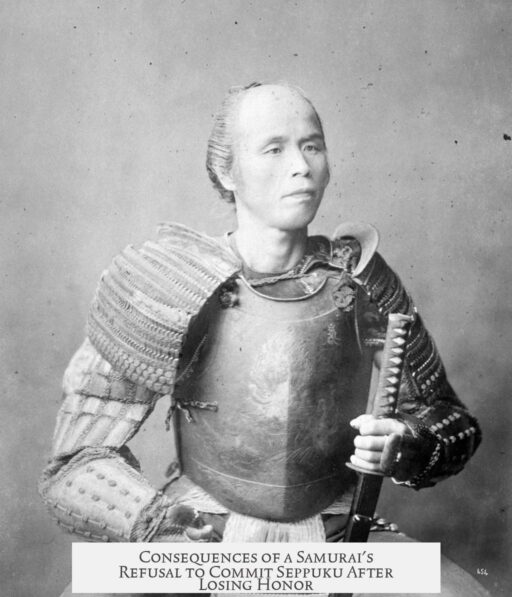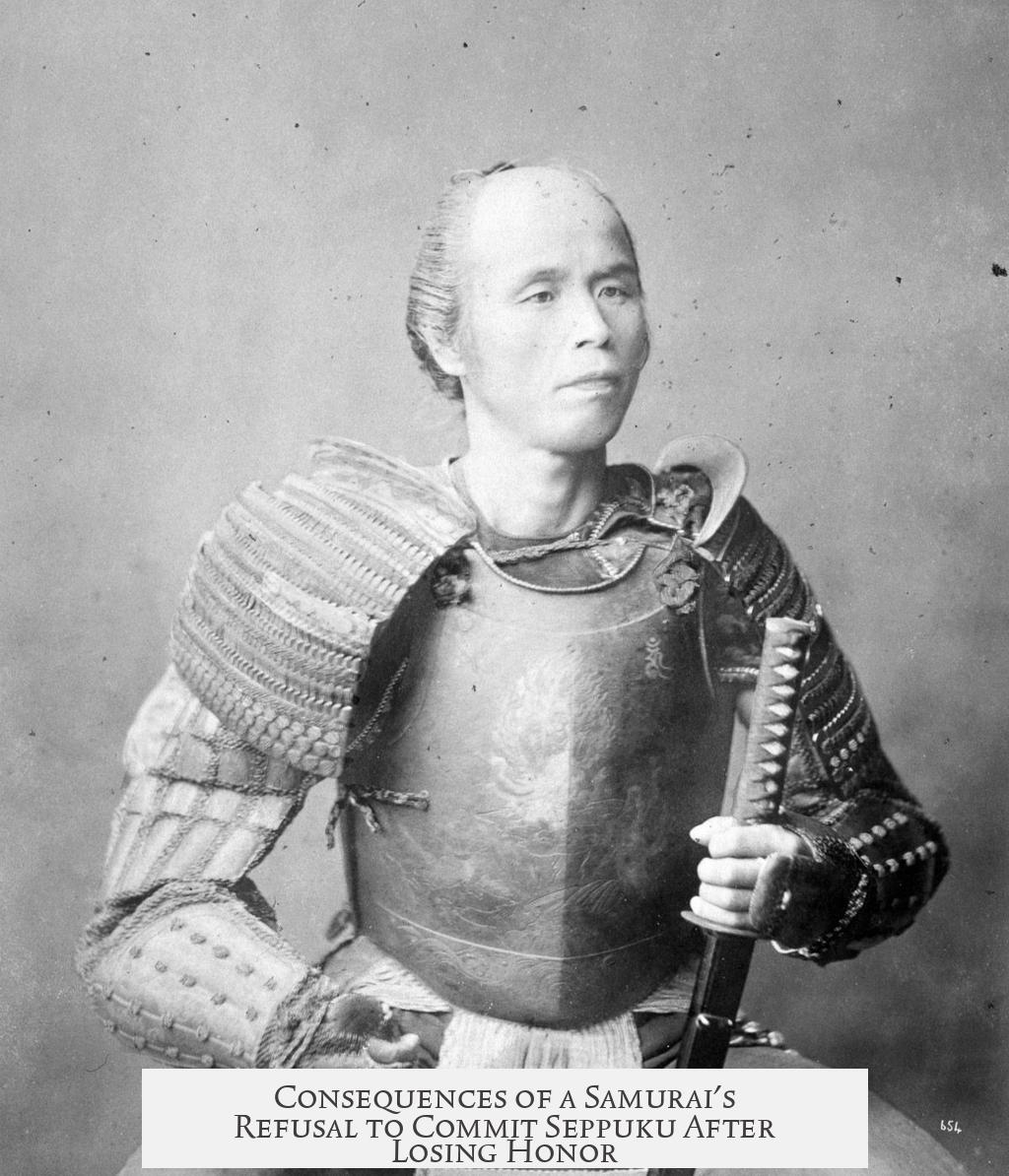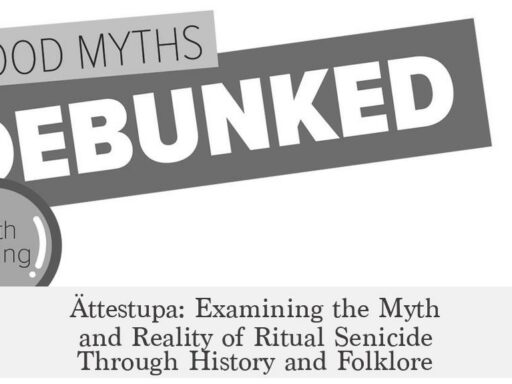If a samurai refused to commit seppuku after losing their honor or being ordered to do so, they would not be allowed to avoid the ritual. The structured ceremony and the presence of attendants guarantee the completion of the act by either ritual compliance or forcible intervention.
Seppuku, also known as harakiri, is a ritual form of suicide historically practiced by samurai to restore honor, demonstrate loyalty, or atone for grave mistakes. During feudal Japan, this act was sometimes voluntary but often commanded by superiors. Refusal was not an option when ordered.
Samurai were privileged to die by their own hand, rather than suffer execution like common criminals. This “honor” granted them the right to perform seppuku with dignity. However, once the command was issued, the samurai was expected to fulfill it fully.
In practice, refusal to complete seppuku either resulted in the ritual being carried out forcibly or with adjustments to minimize refusal or suffering. The process involved key ceremonial figures such as the master of ceremonies and a designated “second” (kaishakunin), whose role was to decapitate the samurai after they made the initial self-inflicted cut.
- The master of ceremonies ensured the ritual proceeded without chaos. They had various strategies to prevent resistance, including starting immediately upon the samurai’s initial move.
- Sometimes, a fan replaced the dagger to reduce the risk of violent resistance or suicide attempts without compliance.
- The second was ready to decapitate the samurai at the first sign of hesitation or refusal, making physical resistance futile.
Historical incidents illustrate this. In 1681, Oguri Mimasaka attempted to resist by grabbing his dagger and fighting back. Attendants physically restrained him, and he was ultimately beheaded to complete the ritual. Such episodes were rare but demonstrate that refusal could provoke violence, which attendants suppressed.
The ritual structure also reinforced compliance psychologically. The solemnity, ceremonial preparation, and cultural importance instilled resolve in the samurai. Many found the ritual emboldening, helping to overcome hesitation at the final moment.
Moreover, not all seppuku required the full ritual act of disembowelment. The 47 ronin, famous for their vendetta in 1703, only reached for their daggers before being promptly beheaded by their seconds. This demonstrates flexibility in execution, especially when the samurai showed readiness but did not follow through completely.
In summary, refusal to commit seppuku did not mean the samurai escaped death or dishonor. The ceremonial system and attendants’ roles ensured that the ordered death was fulfilled either by self-infliction or compelled action. The samurai had very limited real agency to reject the ritual without provoking forcible completion and potentially greater disgrace.
| Aspect | Details |
|---|---|
| Seppuku Purpose | Restore honor, show loyalty, atone for errors or disloyalty |
| Obligation | Usually ordered by superiors; refusal not accepted |
| Privilege | Death by own hand rather than execution |
| Role of Ceremonial Officials | Ensure ritual completion; prevent resistance |
| Measures Against Refusal | Fan used instead of dagger; attendants restrain; second ready to decapitate |
| Historical Example | Oguri Mimasaka restrained and beheaded after resisting |
| Variations | Immediate beheading upon first motion; partial ritual (47 ronin) |
- Refusal to commit seppuku usually results in forced completion by attendants.
- The ritual’s design discourages hesitation through ceremony and cultural pressure.
- Protective measures reduce risk of violent resistance or escape.
- Death by seppuku maintains samurai honor; refusal carries deeper disgrace.
What Would Happen if a Samurai Refused to Commit Seppuku After Losing Their Honor?
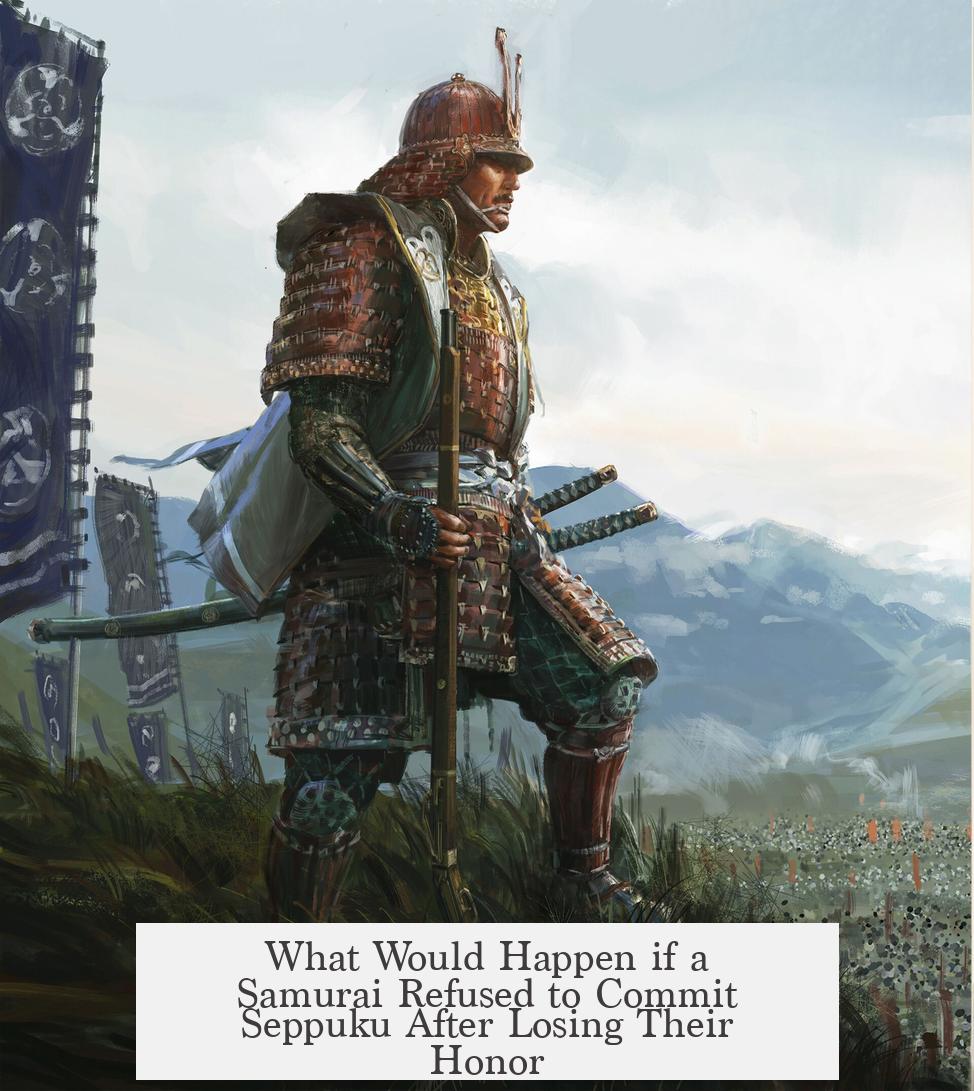
Simply put, a samurai who refuses to commit seppuku after losing their honor does not actually get to refuse. The ritual is either carried out voluntarily, with solemn ceremony and honor, or forcibly completed by attendants. Refusal isn’t a real option; the system is built to ensure the samurai fulfills the act one way or another.
Now, that’s a pretty firm answer. But hold on! Let’s unpack this fascinating, somewhat grim topic with the respect and texture it deserves.
The Weight Behind Seppuku: Why Do Samurai Commit It?
The reasons for seppuku—ritual suicide by disembowelment—vary widely. Sometimes it’s about loyalty, like following a deceased lord in death to demonstrate the ultimate allegiance.
Other times, it’s about protest—disapproval when a lord ignores sound advice. Sometimes, it’s to avoid shameful capture or execution by enemies. And often, to atone for mistakes or crimes, therefore restoring some honor, however modest.
“Maybe you’re staring defeat in the face, and would rather die than be imprisoned and executed.”
In many cases, especially during the Edo Period, seppuku isn’t exactly voluntary. If ordered by one’s superior, refusing seppuku means stepping outside samurai conventions—something more than just frowned upon; it leads to consequences worse than death.
Why Refusal Simply Isn’t on the Table
Samurai culture places enormous emphasis on honor, loyalty, and preserving dignity in death rather than living with disgrace. When the command to commit seppuku comes, refusal is implicitly not an option.
For commoners, punishments might be violent and brutal—by beheading, crucifixion, or worse. Samurai, though, receive the “honor” of dying by their own hand. This distinction is huge and culturally significant.
“As a samurai, you’re extended the honour of death at your own hand.”
Still, what if a samurai hesitates or outright refuses? This is where the ceremonial staff and ritual masters step in. They are trained to handle reluctance or outright resistance.
Masters of Ceremony: Ensuring the Ritual Is Completed
The seppuku ritual is tightly controlled by masters of ceremonies and officials who maintain dignity throughout. They have a range of ways to ensure completion without chaos or refusal spreading.
If a samurai gets cold feet or can’t bring themselves to cut deeply, the second—an appointed companion armed with a sword—steps in.
“The second cuts off their head… This practice began with condemned men who couldn’t be trusted with a dagger.”
So, refusing to commit the act fully doesn’t mean the samurai escapes it. The moment the samurai either hesitates or only lightly wounds themselves, the second performs the decapitation swiftly. This spares prolonged suffering and upholds the ritual’s solemnity.
Security Measures Against Resistance
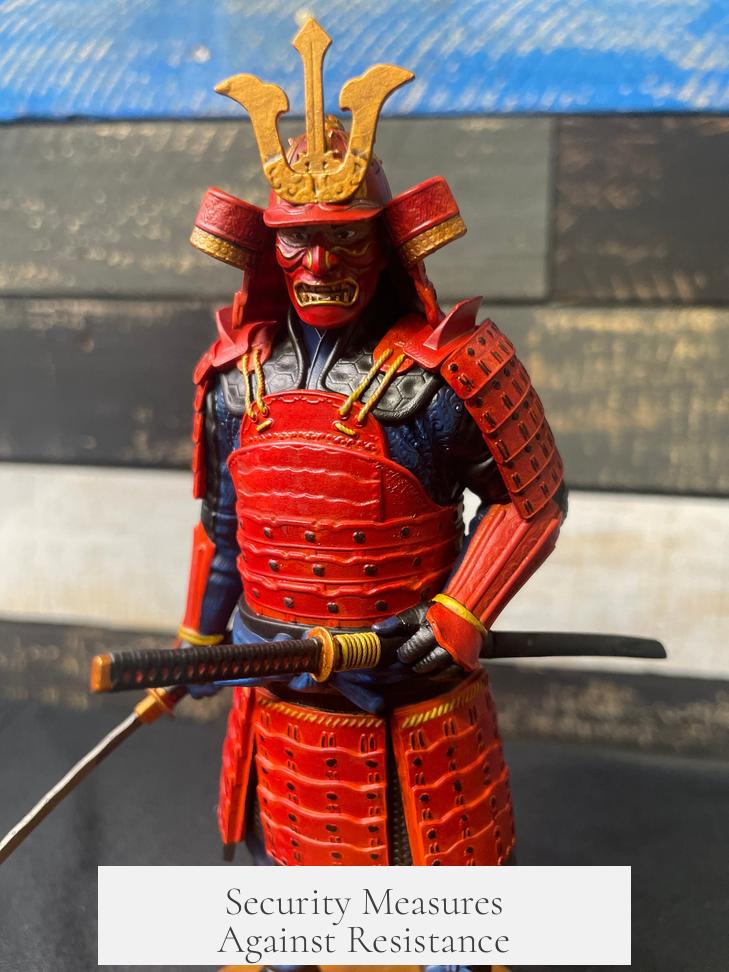
History records occasions when samurai resisted so fiercely that they had to be physically restrained. In 1681, Oguri Mimasaka grabbed his dagger and started a violent fight. Multiple attendants tackled him, and his execution tragically ended with force and his head being sawn off.
This incident left a mark on seppuku manuals. Writers emphasized using fans instead of daggers to prevent threats, and carefully preparing the entire process.
“They suggest a fan as a security measure for potentially dangerous situations.”
So, while the ceremony ideally involves the samurai cutting their own belly, safety and control trump ritual if a samurai becomes dangerously resistant.
Variations on the Ritual: Flexibility in Death
The dramatic image of full disembowelment is partly myth. In many cases, the second cuts the head off quickly once the samurai makes a motion to begin. The famous 47 ronin of 1703, revered in history, were beheaded without ever cutting their abdomens.
“Contrary to legend, the famous 47 ronin … were simply beheaded once they reached for their daggers.”
This variation helps minimize pain and ensures a swift, dignified end. The cultural weight of seppuku focuses more on intention and honor than lengthy agony.
The Power of Ritual and Ceremony
Despite the grim nature, the ritual environment encourages stoicism and courage. Music, prayers, ceremonial dress, and precise movements bolster the samurai’s resolve. Observers find the ceremony deeply moving, underscoring the seriousness of samurai honor.
“All of these are designed to reinforce your belief in this act, and to give you resolution.”
With this powerful cultural and emotional reinforcement, samurai can summon courage they never thought possible.
Summary: The Reality of Refusal
- Refusal to commit seppuku rarely happens since the order is more of a command than a choice.
- If a samurai refuses, attendants ensure the ritual is forcibly completed quickly and respectfully.
- The samurai faces either carrying out the act with honor or losing any remaining dignity through forced execution by second or officials.
- The entire structure around seppuku is designed to remove refusal as a real option and maintain social order and honor.
Why Does This Matter Today?
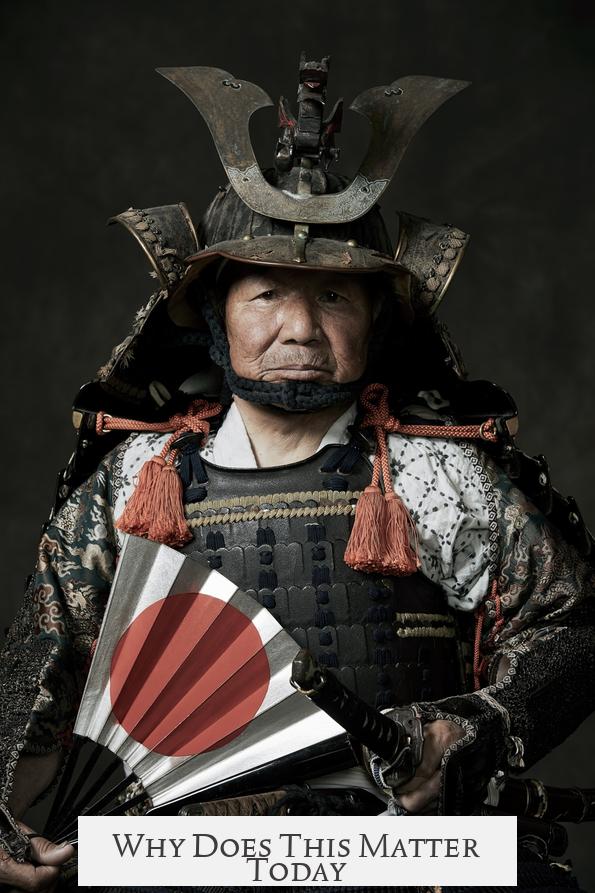
Today, the story of seppuku offers insight into a culture that prized honor so highly it redefined the meaning of death itself. Understanding what happens if a samurai refuses the ritual reveals how even the gravest circumstances were bound by protocol and ceremony.
One can’t help but wonder: If you were a samurai in those shoes, would you muster the courage to follow the ritual, or would you struggle against the inevitable? And more broadly, what does this say about society’s expectations and controlling power?
In any case, seppuku remains a sobering reminder of the tension between personal choice and social obligation.
For Further Reading
If you want a deep dive into samurai culture and seppuku, check out Andrew Rankin’s Seppuku: A History of Samurai Suicide. It’s packed with nuance and historical details you won’t find in movies.
